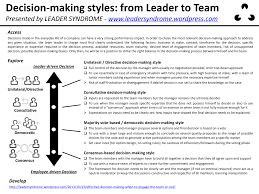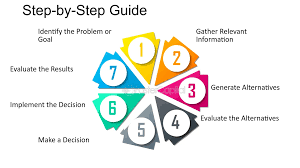The Rational Decision Making Model Steps
Decision making is a crucial aspect of our daily lives, whether it’s choosing what to have for breakfast or making important business decisions. The rational decision-making model provides a systematic process to help individuals make informed and logical choices. Here are the steps involved in the rational decision-making model:
- Identify the Problem: The first step in the rational decision-making model is to clearly identify and define the problem or decision that needs to be made. This involves understanding the current situation and determining what needs to be addressed.
- Gather Information: Once the problem is identified, gather relevant information that will help in making an informed decision. This may involve conducting research, collecting data, and seeking input from others.
- Identify Alternatives: Generate a list of possible solutions or alternatives that could address the problem at hand. Consider different options and evaluate their pros and cons.
- Evaluate Alternatives: Assess each alternative based on criteria such as feasibility, cost, potential outcomes, and alignment with goals. Compare the alternatives to determine which one best meets your needs.
- Make a Decision: After evaluating all alternatives, make a decision based on the information gathered and analysis conducted. Choose the alternative that aligns most closely with your objectives.
- Implement the Decision: Once a decision is made, put it into action by implementing the chosen alternative. Develop an action plan and follow through with the necessary steps to execute your decision.
- Evaluate the Decision: After implementing the decision, evaluate its effectiveness and outcomes. Reflect on whether the chosen alternative has resolved the initial problem or if adjustments need to be made.
The rational decision-making model provides a structured approach to making decisions that can lead to more favorable outcomes. By following these steps, individuals can make well-thought-out choices that are based on logic and reasoning.
Top 5 Advantages of the Rational Decision-Making Model
- Provides a systematic approach to decision making
- Encourages thorough problem identification and analysis
- Helps in evaluating alternatives objectively
- Facilitates informed decision making based on data and information
- Promotes logical reasoning and consistency in decision making
6 Drawbacks of the Rational Decision-Making Model
- Time-consuming process that may delay decision-making
- May overlook creative or innovative solutions
- Assumes all information is readily available and accurate
- Can be rigid and inflexible, limiting adaptability to changing circumstances
- Subject to cognitive biases and personal preferences that can cloud judgment
- Does not account for emotional factors that may influence decision-making
Provides a systematic approach to decision making
The rational decision-making model steps offer a valuable pro by providing a systematic approach to decision making. This structured method allows individuals to methodically navigate through the decision-making process, ensuring that all relevant factors are considered and analyzed in a logical manner. By following a systematic approach, individuals can make informed decisions based on careful evaluation of alternatives and alignment with their goals and objectives. This systematic nature of the rational decision-making model steps helps in promoting clarity, consistency, and efficiency in the decision-making process, ultimately leading to more effective and successful outcomes.
Encourages thorough problem identification and analysis
The rational decision-making model steps encourage thorough problem identification and analysis, which is a key benefit of this approach. By taking the time to clearly define the problem at hand and gather relevant information, individuals are better equipped to make informed decisions. This process helps ensure that all aspects of the problem are considered and that potential solutions are carefully evaluated. By encouraging a comprehensive analysis, the rational decision-making model promotes thoughtful and logical decision-making that can lead to more effective outcomes.
Helps in evaluating alternatives objectively
One of the key advantages of the rational decision-making model steps is that it aids in evaluating alternatives objectively. By following a systematic process that involves gathering information, identifying alternatives, and evaluating them based on specific criteria, individuals can make decisions based on logic and reasoning rather than emotions or biases. This objective evaluation allows for a comprehensive analysis of each alternative’s strengths and weaknesses, leading to a more informed decision-making process that is grounded in facts and data.
Facilitates informed decision making based on data and information
The rational decision-making model steps offer a significant advantage by facilitating informed decision making based on data and information. By following a systematic process of identifying problems, gathering relevant information, evaluating alternatives, and making decisions based on logical analysis, individuals can make well-informed choices. This approach ensures that decisions are not made impulsively or based on emotions but rather on concrete data and facts. Ultimately, the rational decision-making model empowers individuals to make sound decisions that are grounded in information and reasoning, leading to more successful outcomes.
Promotes logical reasoning and consistency in decision making
The rational decision-making model steps offer a significant advantage by promoting logical reasoning and consistency in decision making. By following a systematic process that involves identifying the problem, gathering information, evaluating alternatives, making a decision, implementing it, and evaluating the outcomes, individuals are encouraged to approach decisions with a clear and rational mindset. This method helps in ensuring that choices are based on sound reasoning and objective analysis rather than emotions or impulse. Consistency in applying this model can lead to more reliable and effective decision-making outcomes across various situations.
Time-consuming process that may delay decision-making
One significant drawback of the rational decision-making model steps is that it can be a time-consuming process, potentially leading to delays in decision-making. The thoroughness and systematic approach of identifying problems, gathering information, evaluating alternatives, and implementing decisions may require considerable time and effort. In fast-paced environments where quick decisions are often necessary, following each step of the rational model may not always be feasible. This delay in decision-making could result in missed opportunities or hinder timely responses to urgent situations. Balancing the need for a comprehensive decision-making process with the urgency of certain situations is crucial to effectively utilizing the rational model.
May overlook creative or innovative solutions
One potential drawback of the rational decision-making model steps is that it may overlook creative or innovative solutions. The structured nature of this model, with its emphasis on gathering information, evaluating alternatives, and making logical choices, can sometimes limit thinking to conventional or traditional options. In situations where unconventional or out-of-the-box solutions may be more effective, relying solely on the rational decision-making model may hinder the exploration of creative ideas. This con highlights the importance of balancing analytical reasoning with creativity in decision-making processes to ensure all possibilities are considered.
Assumes all information is readily available and accurate
A significant drawback of the rational decision-making model is its assumption that all information required for making a decision is readily available and accurate. In reality, information can be incomplete, uncertain, or even misleading, which can lead to flawed decision-making outcomes. Relying on the premise that all information is easily accessible and correct may result in overlooking crucial factors or underestimating potential risks. This limitation highlights the need for decision-makers to acknowledge and address uncertainties in information when using the rational decision-making model to ensure more realistic and effective decision outcomes.
Can be rigid and inflexible, limiting adaptability to changing circumstances
One significant drawback of the rational decision-making model steps is its tendency to be rigid and inflexible, which can limit adaptability to changing circumstances. By following a strict process of identifying problems, gathering information, evaluating alternatives, and making decisions, individuals may overlook the need for flexibility in response to unexpected changes or new information. This rigidity can hinder the ability to adjust decisions quickly in dynamic environments, potentially leading to suboptimal outcomes when faced with rapidly evolving situations. The emphasis on logic and reasoning in the rational decision-making model may sometimes disregard the importance of adaptability and creativity in decision-making processes.
Subject to cognitive biases and personal preferences that can cloud judgment
One significant con of the rational decision-making model steps is that individuals are subject to cognitive biases and personal preferences that can cloud their judgment. Despite the structured approach of the model, human beings are inherently prone to biases and influenced by their own subjective beliefs and experiences. This can lead to decisions being made based on emotions, stereotypes, or preconceived notions rather than solely on objective analysis and logic. As a result, the rational decision-making process may be compromised, impacting the quality and accuracy of the final decision. It is essential for individuals to be aware of these cognitive biases and personal preferences in order to mitigate their influence and make more objective decisions.
Does not account for emotional factors that may influence decision-making
One significant drawback of the rational decision-making model is its failure to consider emotional factors that can heavily impact the decision-making process. Emotions play a crucial role in shaping our perceptions, preferences, and judgments, yet the rational model tends to prioritize logical reasoning and objective analysis over emotional considerations. Ignoring emotions in decision making can lead to choices that do not fully resonate with an individual’s values, beliefs, or desires. Emotions can cloud judgment, introduce bias, and influence decisions in ways that may not align with purely rational thinking. By overlooking emotional factors, the rational decision-making model may not always result in decisions that are truly reflective of an individual’s holistic needs and motivations.




